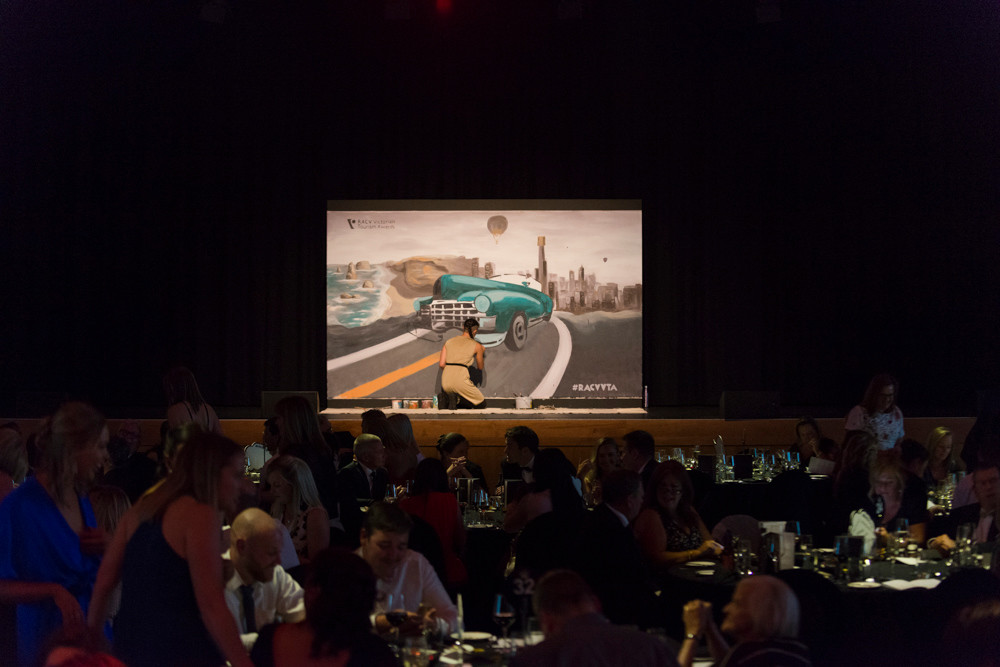Tips on Live Painting
“Live painting"—when an artist is commissioned to create something in front of an audience—is quickly becoming a popular entertainment option at events such as corporate dinners, award nights, underground parties, exhibitions, and cultural festivals. Painting live at an event is an interesting and non-intrusive way to entertain an audience. Most people never get the chance to see a piece of art unfold, and find it fascinating to watch it progress.
If you are an artist, live painting can be a great opportunity to network and get your art seen, though it is completely different than creating something alone in the peace and quiet of your studio. Here are some tips to help you paint live in front of an audience.
Plan a piece that suits the event. When choosing what to paint, think about how you will paint it and whether it will be both interesting to watch and achievable in the duration of the event. Choose a theme and style with which you are very comfortable.
Pick materials suitable for the space. If you are painting indoors or near people eating, do not use aerosols or paints with strong fumes. If you are painting in a pristine environment with expensive carpet, don’t plan to create a piece that will involve splashing lots of paint around.
Go big. The point of live painting is for people to watch it happening. Your piece needs to be big enough so your body won’t block it, and should require you to move your arms and body, not just your hands. Unless it is a very small event, don’t go smaller than one square meter.
Prepare as much as possible. If you are feeling nervous, why not do a practice run? You can paint the same painting or something similar the day before, perhaps on a smaller surface, to check your process and palette. This will help you build confidence and plan your timing.
Depending on your style, it might be a good idea to sketch the painting on the surface before the event to save time. If you use light chalk or pencil, the audience won’t be able to see the sketch; it will look as if you are creating something completely from scratch.
Keep in mind that while you’re painting, you will be seen and photographed as much as the artwork. Think about how your choice of clothes can complement the art.
Get an efficient setup. Visit the venue beforehand so you can plan how to arrange your materials and tackle any problems with lighting, space, etc. Set up your materials within easy reach. Consider getting a small table for your supplies so you won’t have to lay them on the floor.
Use a limited colour palette. If you have to mix specific colours, mix them before the event. It will make the painting go a lot more smoothly if you have all the right colours and can just focus on applying them to the piece.
If you are using reference materials, don’t spend the event looking at them on your smartphone. Print out the images and have them somewhere accessible. I like to stick mine with tape to the floor in front of the painting, so my hands are free and I can check them easily, without detracting from the piece.
Consider movement and timing. While you are painting, think about your body as part of the performance. Can you make your movements more dramatic and interesting to watch? If possible, position yourself in a way that allows people to see your hands and the brushstrokes you make.
Guests will want to photograph your finished work and talk to you about your art. Finish your painting before the event ends to leave enough time to network. To make sure you are not going too quickly or slowly, divide your process in stages and set milestones for certain times. Keep a watch or phone handy so you can check your progress.
Remember: no one is judging you. It’s easy to feel nervous when you have an audience behind you, and to think people are judging your every move. Don’t let your mind go down that path. Remind yourself that people are there to have fun; they are busy interacting with each other, not staring at you constantly. Most people don’t understand the process behind a painting and won’t even notice if you do something wrong. If you make a mistake or spill paint, don’t panic: stop, take a deep breath, and just follow the steps to fix it.
Júlia Both is a visual artist from Brazil. Since moving to Melbourne in 2013, she has run Mayfield Palace, a partnership that creates art for businesses and organisations all over Australia. She shares her work regularly on Instagram (@artofboth) and at artofboth.com.


